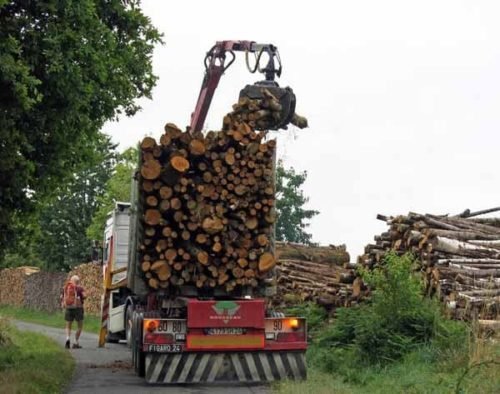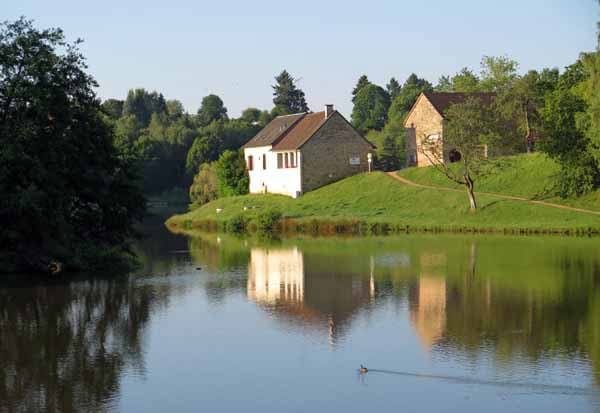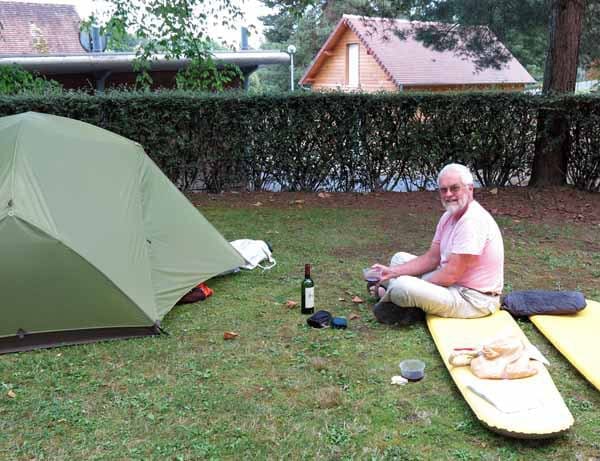
Wednesday, 2 July 2014
Distance 19 km
Duration 4 hours 20 minutes
Ascent 266 m, descent 186 m
Map 147 of the TOP100 lime-green series
The night’s rain had washed our clothes a second time and they were sodden, so I stuffed them into a plastic bag and we stayed in the clothes that we had been wearing for the last 24 hours.
As every leaf and grass blade was wet, we took our gear down to the bar and had our muesli there. Naturally, it was closed but we were dry and comfortable under the roof.
By 7 am we were marching along the little road that we had arrived on, as it continued past the camping ground. First there was a stiff climb, after which it levelled out and we came to the D75.
We went left along this for a little way and then took the first turn to the right, a thin, potholed road under a canopy of spreading trees.

In due course the road dipped and we crossed the Auvézère on a stone bridge, beside a cottage that had the look of a former mill.
As we climbed out of the valley our way was blocked by an enormous truck with a mechanical arm lifting logs from the pile that stretched out of sight along the road verge.
The driver courteously stopped his operation as we edged past.

About a kilometre beyond the bridge we passed the tiny settlements of Aubisse and la Chassignole Basse, sitting like mother hens among their fields, which were inhabited by chestnut cattle and newly-shorn sheep with ears like small wings. The land was now quite flat so the walking was easy.
Our little road ran into another one and we had to make a sharp zig-zag to find the continuation of our way, which was a dirt track flanking a wood. It was spongy underfoot with last year’s dead leaves and had the smell of compost, the gardener’s perfume.
The drawback was that the rain of the day before had soaked everything, and we soon had wet socks, which was a worry – in our experience, wet feet mean blisters to follow.

Presently we rejoined the bitumen and passed through a patchwork of forests and fields.
At la Juvénie Gare (a private house that was once a station – last vestige of a vanished railway line) we came to a more serious road, the D18A.
At this point we had to decide whether to press on towards St-Yrieix on the lanes and paths that we had worked out, or to take the tar road straight to Glandon in the hope of coffee. After a short struggle with our puritanical side, we chose the latter.

It only took half an hour to get to Glandon. The main road curved up past an avenue of trees and tall white houses, towards the awning of a bar.
When we got near we saw that the door of the bar was closed and the terrace was empty, but just as we started to despair, the door opened and a customer walked out. It was only the coldness of the morning that had caused our anxiety.
Inside in the warmth, the counter was lined with local men in boots. We preferred to sit, having been trudging in our boots for almost three hours. Also we were hungry after our meagre muesli breakfast.

The barman pointed me towards a boulangerie further along the highway, but he did not say how much further, and I was ready to give up by the time I saw the red neon sign. However, the journey was worth it.
Back in the bar, we quietly removed our wet boots to allow our socks to steam off, and demolished the croissants and coffee whilst reading the local paper. It was a moment of delicious repose.

The walk into St-Yrieix was about five kilometres and we accomplished it in quick time. Scattered roadside houses gradually became a continuous canyon of masonry as we reached a low crest and started down into the town itself.
We came to the Place de la Nation, a handsome sloping avenue of trees lined with shops and cafes, but we resisted its charms and pressed on, looking for the Office of Tourism, which we found a little way below. We hoped to be able to send an email from there.
The man at the Office said that we could send an email from the Cyber-Base just around the corner, near the Hôtel de Ville.
When we got there it was 11:40 am and it closed for lunch at 12, so we hurriedly sent off a bulletin. There was no time to look at messages received before we were politely ushered out the door.

We only had to walk a few more blocks to arrive in the old quarter of the town, which was the usual fascinating maze, loomed over by the dark stones of the church.
Considering that it was a town that we had never heard of until this year, St-Yrieix was surprisingly touristy, but that was fine by us. Bars and cafés are things of beauty to the weary walker.
We chose a boulangerie on the lower road, which was also a Salon de Thé.
Inside it was beautifully light and clean, and we sat against a window with our coffee and a large custard pastry called a Jésuite. Having disposed of every drop and every crumb, we set off on the final stage of the day’s walk.

The camping ground was at a nearby lake (the Plan d’Eau d’Arfeuille) a couple of kilometres further on, along a little road that ambled under a railway viaduct. The immensely tall stone arches of this viaduct made us wonder whether the Romans had invented railways.
In the camping ground we paid our money and took up residence in a hedged space overhung by generously shady trees. When we started putting up the tent we discovered that the ground was pure gravel with an overlay of moss, but that was no problem with our wonderful self-supporting tent.
We laid our wet washing from yesterday on the hedge to dry, and when it was wearable, we went off to the showers to wash ourselves and our two-day old walking clothes, which then took their turn on the hedge.
The afternoon was cool, with rain threatening. We lay about reading for a while, and when the sky cleared, we descended to the office to ask directions to the lakeside restaurant that we had heard about.

Unfortunately for us, it was closed on Tuesdays and Wednesdays, but the woman assured us that there were two other eateries nearby, if we walked around the lake shore past the closed restaurant, then went up to the highway and turned left. As we had nothing better to do, we decided to investigate.
Following her instructions, we ended up on a desolate stretch of open road (the D704), heading in the general direction of Limoges, so we turned back and eventually came to an industrial area, where we found the two restaurants.
One was only open for lunch and the other was a sad little take-away pizza shop with a sign on the door saying that it would open at 19 hours.

We did not feel like coming back later, so we kept going to a roundabout and took a steep little road back to the lake. (This road must have been the one that madame meant us to go up.)
There was a sign outside the camping office advertising a shuttle bus into town at 6 pm, with regular return buses until 10 pm. It was just after six but we rushed hopefully in to ask whether it had left, only to be told that the service did not start until next week.
If we had not already walked so far, we could easily have strolled back to town and had a fine meal, but somehow we had lost the urge.
Instead we bought a bottle of red wine and a jar of paté at the office and went back to our tent.
Some new campers had set up next to us, a Dutch couple on their way to holiday in the Pyrénées. Their English was perfect, of course.

The man was cadaverously thin and the woman plump, dark-haired and much younger.
They lived in the far north of Holland, in a reclaimed sea marsh, and she worked in Brussels during the week, several hours drive away. We got the feeling that she had an exalted position there, whereas he was a humble retired army dog-handler.
Our food stocks were low. Apart from the wine and paté that we had just bought, we had a scrap of duck from two nights ago, some steak from last night and four little rounds of stale bread. When we had eaten, our neighbours invited us to have coffee with them, so it was a pleasant evening after all.
Previous day: St-Robert to Payzac